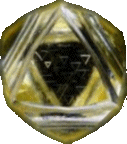| |
Diamond
|
The diamond is the hardest natural substance known to man. This should not be confused with indestructability, as the hardness of the stone causes it to be much more brittle than a stone such as jade. Known today as the King of Gems, the diamond is crystallized carbon, and contrary to popular belief is not an extremely uncommon stone. In fact, the cost of the diamond can be solely attributed to cleaver marketing and monopolistic practices by major companies. Even its association with wedding rings is a quite modern practice, whereas prior to the last century, a stone such as the sapphire would have been a much more likely choice.
In Greek adamastos means unbreakable, unrelenting or unconquerable. It is through the French translation of the term, adamant, that we get the name diamond. This entomological transmission has also caused the modern diamond to be confused with other materials in early lapidaries. Because adamas means unbreakable or indestructible the name has also been applied to other materials such as steel and jade in addition to the crystalized carbon we know as the diamond today. This confusion was compounded by phonetic adaptations of French lapidaries that mixed up the word for lodestone, aimant, with the old French word for diamond, aymaut. This conflation of folklore explains why many of the older lapidaries include discussions of the magnetic properties of the diamond, which is nonferrous and magnetically inert.
The folklore is farther complicated due to the belief that the diamond was a harder form of quartz due to visual similarities. This myth usually took the form of attributing the stone’s hardness to it the belief that it was primordial ice that dated from the beginning of creation, or that it had had longer to “ripen” underground as opposed to unripe quartz. The diamond’s hardness made it unworkable until only a few centuries ago, and so humanity has had less time to bestow it with folklore.
Much of the earlier folklore comes out of India. Since the stone was used uncut the folklore focused on the size, color and clarity of the raw crystal. Some of this folklore also seems to conflate the zircon with the diamond due to shape and hardness. This can be seen by the multiple discussions of red diamonds in Vedic texts. Where red is one of the rarest colors in diamond it is very common in zircon.
Strangely much of the later folklore focuses on poisons, both the toxicity of the stone itself and the remedy it can provide. The belief that the stone was fatal could be caused by the desire not to have precious stones stolen by swallowing them. The diamond’s association with poison was woven into its origin stories by writers in Hellenistic Greece who claimed the stone came from a deep valley filled with venomous serpents. Legend had it that the only way to retrieve the stone was to toss raw or undercooked meat into the valley. The diamonds would stick to the bloodied flesh, and the meat would be retrieved by local birds, who would return to their nests along the ridges of the valley with their prize. The diamonds would drop off in their feasting could then be collected safely.
It should be noted that most of the stories of poisoning by diamond referred to powdered diamond being slipped into someone’s food. Diamond dust was rumored the chosen method of assassination by some of Europe’s most elite families such as the Medici. This toxicity was supposed to have been discovered after medieval doctors started prescribing diamond dust as a cure all remedy, causing the death of many patients. This intersection of folklore, science, and human nature may provide some insight into why the belief was so wide spread.
Benvenuto Cellini recorded a story in the 1500s of how he was almost assassinated by a guard who put diamond dust into his food while Cellini was imprisoned. Upon discovering some particles Cellini was vexed and prepared for his death until he decided to crush a piece of the suspect material. When he could smash the particle with a stone, he knew it was not a diamond and realized he would live. After Cellini got out, he tracked down the lapidary who sold his rival the diamond powder. The lapidary confessed that he had substituted a cheap citrine for the more expensive diamond since none would know once it was powdered.
Cellini’s story is only one of many about near escaped due to jewelers substituting other stones for diamond powder. Given the demand for diamond dust, the expense of producing it, and the ease in which it could be faked or adulterated; there is the strong possibility that many of the individuals died not from eating diamonds dust but from crushed glass being passed off as the much more expensive substance. Ground Glass would cause much of the internal hemorrhaging and organ damage attributed often to diamonds, at a fraction of the cost to produce.
Several lapidaries speak of the diamond’s ability to detect poison or deceit by changing color. It was also said to make a man invincible and bestow health and strength to his body, as well as protecting him from enemies, sickness, and storms. But perhaps most interesting was the diamond’s ability to ward off demons, sorcery, and madness. It should be noted that many of these lapidaries also contained the warning that in order for the diamond to gain these virtues it must be given as a gift and could not be bought or haggled for, and that the sins and transgressions of the wearer would taint the gem and make it lose its virtues.
|
Colors
|
Diamonds can be found in all colors.
|
Locations
|
Africa, Canada, USA, South America
|
Compisition
|
C, Crystaline carbon
|
Hardness
|
10
|
|

|

|

|
|
|
|
|
|